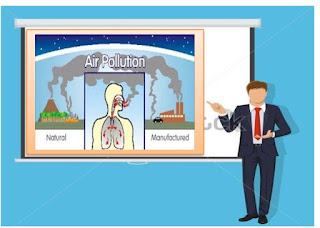Lesson Plan of Air Pollution (Pollutants and Their Effects on Environment General Science Grade VIII
Lesson Plan of Air Pollution (Pollutants and Their Effects on Environment
General Science Grade VIII
Students’ Learning Outcomes
·
Explain the sources,
properties and harmful effects of air pollutants.
Information for Teachers
·
Pollution is a process
through which harmful substances are added to the environment and these harmful
substances are called pollutants. Presence of these substances in air is called
air pollution.
·
Air pollution is mainly
caused by dust, sulfur dioxide, carbon dioxide, nitrogen oxide, hydrocarbons
and ozone.
·
The air pollutants added into
the air may be due to human activities (e.g. Burning of fossil fuels, exhaust
fumes from motor vehicles and burning of garbage.) and natural occurrences
(e.g. biological decay, forest fires or volcanic eruptions)
·
Air pollution damages or
defiles the environment, making it undesirable or unfit for life.
·
Pollution sound effects are
indeed various and wide-ranging.
·
There is no doubt that
extreme stages of pollution are causing a lot of harm to human & animal
health, tropical rain forests, as well as the broader environment.
Concept Map
Material / Resources
Board, chalk/marker, chart, colored cards,
scissors, white sheets, gum
Worm up activity
·
Brainstorm the students by asking
the following questions:
o What do you mean by pollution?
o Do you know about the different types of
pollution?
o What are the causes of pollution?
o What are the effects of pollution on our health
and environment?
Development
Activity 1
·
Draw the diagram on the board as shown below and
ask the students about the air pollutants, its causes, and effects on the
environment and health.
·
Activity 2
·
Draw this figure or paste
already drawn figure on a board showing an important source of air pollution
and ask questions from the students.
·
Write these questions on the
board and complete it by the students.
·
image
·
X’ is a gaseous pollutant that
gives rise to ‘y’. identify ‘x’ and ‘y’
X
|
Y
|
A.
Carbon dioxide Hailstones
B.
Carbon monoxide Acid rain
C.
Chloroflouro carbon Thunderstorm
D.
Sulfur dioxide Acid rain
· How ‘y’ does affect the forests in long term?
A.
|
A.
It reduces its rate of
transpiration.
B.
It kills the trees.
C.
It reduces its
photosynthesis.
Sum up / Conclusion
·
Ask the students following
questions
o define pollution,
(Expected response will be: Pollution is a
process through which harmful substances are added to the environment.)
o What are pollutants?
(Expected response will be: Harmful substances
are added to the environment by pollution.)
o What are the major causes and effects of air
pollution?
(Expected response will be: Air pollution is mainly
caused by dust, sulfur dioxide, carbon dioxide, carbon monoxide, nitrogen
oxide, hydrocarbons and ozone. it may also be due to human activities (e.g.
burning of fossil fuels, exhaust fumes from motor vehicles, and burning of
garbage.) and natural occurrences (e.g. biological decay, forest fires or
volcanic eruptions). Air pollution damages or defies the environment, making it
undesirable or unfit for life.
Assessment
·
Ask the students to solve the
following question:
Follow up
·
Write the following question
on the board and ask them to copy and solve as homework on their notebooks:
·
Since sulfur dioxide is the
major pollutant because of human activities, what suggestions would you give to
reduce its release into the atmosphere?
·
What can you do to prevent
the further thinning of the ozone layer?







Comments
Post a Comment